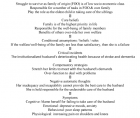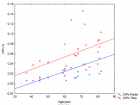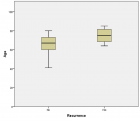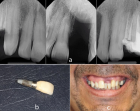Abstract
Research Article
Racial and Ethnic Disparities in Pregnancy-related Complications: Findings at Mansa General Hospital and 2nd Affiliated Hospital of Nanjing Medical University
Kasonde Chanda, Liang Sheng Lian, Kong Yi Yan, Huang Qian, Gulidiya Abulikem, Royd Nkalamo Nonde and Ying Xiao Yan*
Published: 16 June, 2023 | Volume 6 - Issue 2 | Pages: 065-075
Background: 800 women die and 2.6 million stillbirths occur worldwide related to pregnancy complications. Racial/ethnic disparities in pregnancy-related mortality have continued to be significantly higher among black than whites due to various factors. We sought to investigate complications among pregnant women of different race/ethnicity.
Methods: Cross-sectional observational study of 2030 obstetric cases randomly selected for the period January 1 to December 31, 2021. Data was collected from the hard copy and electronic inpatients’ records. Analysis was performed using SPSS version 23. Descriptive statistics analyzed the pregnancy complication frequencies, standard deviations, range, minimum and maximum values. Maternal characteristics were analyzed using an independent samples t-test. Maternal characteristics were evaluated using the two samples t-test. The odds ratios and confidence intervals were calculated as measures of association between ethnicity/race and pregnancy complications using a binary logistic regression model. Confidence interval was set at 95% and p < 0.05 (2-tailed) was considered statistically significant.
Results: 76.25% of Chinese and 67.86% of Zambians were affected by one or more complications. The mean ± standard deviation for MGH [age (26.69 ± 7.33), gravidity (3.35 ± 2.08), and parity (2.07 ± 1.68)] and for 2nd affiliated hospital was [age (30.04 ± 4.29), gravidity (2.19 ± 1.38) and parity (0.45 ± 0.55)]. Prevalence of top five pregnancy complications in the Chinese group was gestational diabetes mellitus at 18.41%, hypothyroidism at 15.91%, oligohydramnios at 14.39%, premature rupture of membranes at 12.17%, and anemia at 5.73%. The prevalence of the top five pregnancy complications in the Zambian group was preeclampsia at 13.80%, PIH at 12.74%, PROM at 12.45%, eclampsia at 7.53%, and placenta abruption at 7.43%. Statistical significance findings were noted as follows: Oligohydramnios [OR 0.02, CI (0.01 - 0.05), p = 0.000], placenta praevia [OR 0.08, CI (0.01 - 0.61), p = 0.015], preeclampsia [OR 13.10, CI (7.22 - 23.78), p = 0.000], placenta abruptio [OR 79.73, CI (11.07 - 574.38), p = 0.000], PIH [OR 11.95, CI (6.57 - 21.73), p = 0.005], eclampsia [OR 162.90, CI (10.08 - 2631, p = 0.000), PPROM [OR 0.03, CI (0.00 - 0.45), p = 0.012], GDM [OR 0.11, CI (0.07 - 0.17), p = 0.000], hypothyroidism [OR 0.01(0.00-0.03), p = 0.000], anemia [OR 0.18, CI (0.92-0.34), p = 0.000], ICP [OR 0.03, CI (0.00 - 0.48), p = 0.013], syphilis [OR 7.17, CI (2.14 - 24.02), p = 0.001], UTI [OR 22.55, CI
(3.04 - 17.26), p = 0.002], HBV [OR 0.05, CI (0.00 - 0.86), p = 0.039] and GBS [OR 0.06, CI (0.00 - 1.11), p = 0.059].
Conclusion: Highest odds for obstetrical and infection-related pregnancy complications were associated with Zambian cases. The highest odds for medical complications were associated with Chinese cases.
Read Full Article HTML DOI: 10.29328/journal.cjog.1001131 Cite this Article Read Full Article PDF
Keywords:
Ethnic and race; Pregnancy-related complications; Maternal health
References
- World Health Organization. Maternal mortality 2019. RetrievedJanuary15,2020, from https://www.who.int/en/news-room/fact-sheets/detail/maternal-mortality
- Pregnancy complications 2018. Retrieved March 3, 2020, from https://www.cdc.gov/reproductivehealth/maternalinfanthealth/pregnancy-complications.html.
- Lassi ZS, Kedzior SG, Bhutta ZA. Community-based maternal and newborn educational care packages for improving neonatal health and survival in low- and middle-income countries. Cochrane Database Syst Rev. 2019 Nov 5;2019(11):CD007647. doi: 10.1002/14651858.CD007647.pub2. PMID: 31686427; PMCID: PMC6828589.
- Blencowe H, Krasevec J, de Onis M, Black RE, An X, Stevens GA, Borghi E, Hayashi C, Estevez D, Cegolon L, Shiekh S, Ponce Hardy V, Lawn JE, Cousens S. National, regional, and worldwide estimates of low birthweight in 2015, with trends from 2000: a systematic analysis. Lancet Glob Health. 2019 Jul;7(7):e849-e860. doi: 10.1016/S2214-109X(18)30565-5. Epub 2019 May 15. PMID: 31103470; PMCID: PMC6560046.
- Liang J, Li X, Kang C, Wang Y, Kulikoff XR, Coates MM, Ng M, Luo S, Mu Y, Wang X, Zhou R, Liu X, Zhang Y, Zhou Y, Zhou M, Li Q, Liu Z, Dai L, Li M, Zhang Y, Deng K, Zeng X, Deng C, Yi L, Zhu J, Murray CJL, Wang H. Maternal mortality ratios in 2852 Chinese counties, 1996-2015, and achievement of Millennium Development Goal 5 in China: a subnational analysis of the Global Burden of Disease Study 2016. Lancet. 2019 Jan 19;393(10168):241-252. doi: 10.1016/S0140-6736(18)31712-4. Epub 2018 Dec 13. PMID: 30554785; PMCID: PMC6336935.
- Luo XL, Zhang WY. Obstetrical disease spectrum in China: an epidemiological study of 111,767 cases in 2011. Chin Med J (Engl). 2015 May 5;128(9):1137-46. doi: 10.4103/0366-6999.156076. PMID: 25947393; PMCID: PMC4831537.
- Luo XL, Zhang WY. Obstetrical disease spectrum in China: an epidemiological study of 111,767 cases in 2011. Chin Med J (Engl). 2015 May 5;128(9):1137-46. doi: 10.4103/0366-6999.156076. PMID: 25947393; PMCID: PMC4831537.
- Lawn JE, Kinney MV, Black RE, Pitt C, Cousens S, Kerber K, Corbett E, Moran AC, Morrissey CS, Oestergaard MZ. Newborn survival: a multi-country analysis of a decade of change. Health Policy Plan. 2012 Jul;27 Suppl 3:iii6-28. doi: 10.1093/heapol/czs053. Erratum in: Health Policy Plan. 2013 Oct;28(7):786-8. PMID: 22692417.
- Hickey MU, Kasonde JM. Maternal mortality at University Teaching Hospital, Lusaka. Med J Zambia. 1977 Jun-Jul;11(3):74-8. PMID: 302537.
- McClure EM, Wright LL, Goldenberg RL, Goudar SS, Parida SN, Jehan I, Tshefu A, Chomba E, Althabe F, Garces A, Harris H, Derman RJ, Panigrahi P, Engmann C, Buekens P, Hambidge M, Carlo WA; NICHD FIRST BREATH Study Group. The global network: a prospective study of stillbirths in developing countries. Am J Obstet Gynecol. 2007 Sep;197(3):247.e1-5. doi: 10.1016/j.ajog.2007.07.004. PMID: 17826406; PMCID: PMC2150563.
- Vogel JP, Souza JP, Mori R, Morisaki N, Lumbiganon P, Laopaiboon M, Ortiz-Panozo E, Hernandez B, Pérez-Cuevas R, Roy M, Mittal S, Cecatti JG, Tunçalp Ö, Gülmezoglu AM; WHO Multicountry Survey on Maternal and Newborn Health Research Network. Maternal complications and perinatal mortality: findings of the World Health Organization Multicountry Survey on Maternal and Newborn Health. BJOG. 2014 Mar;121 Suppl 1:76-88. doi: 10.1111/1471-0528.12633. Erratum in: BJOG. 2015 Feb;122(3):451. PMID: 24641538.
- Powell Bill. Gender Imbalance: How China's One-Child Law Backfired on Men; China's one-child policy has had one unlikely aftereffect: empowering women. Newsweek, 5 June 2015. AcademicOneFile, http://link.galegroup.com/apps/doc/A415402385/AONE?u=cuny_guttman&sid=AONE&xid=d6f643f6. Accessed 14 May 2018.
- Guo C, Pang L, Ding R, Song X, Chen G, Zheng X. Unmarried Youth Pregnancy, Outcomes, and Social Factors in China: Findings From a Nationwide Population-Based Survey. Sex Med. 2019 Dec;7(4):396-402. doi: 10.1016/j.esxm.2019.07.002. Epub 2019 Aug 23. PMID: 31451396; PMCID: PMC6963114.
- Luo XL, Zhang WY. Obstetrical disease spectrum in China: an epidemiological study of 111,767 cases in 2011. Chin Med J (Engl). 2015 May 5;128(9):1137-46. doi: 10.4103/0366-6999.156076. PMID: 25947393; PMCID: PMC4831537.
- Dekker R, Breakey AA. Evidence on advanced maternal age. Evidence Based Birth. 2016.
- Zambia Demographic and Health Survey 2018.
- Population Council, UNFPA, and Government of the Republic of Zambia. 2017. “Adolescent Pregnancy in Zambia.” Lusaka, Zambia.
- Ashraf N, Field E, Rusconi G, Voena A, Ziparo R. Traditional Beliefs and Learning about Maternal Risk in Zambia. Am Econ Rev. 2017 May;107(5):511-5. doi: 10.1257/aer.p20171106. PMID: 29553631.
- China allows three children in major policy shift. 2021. https://www.bbc.com/news/world-asia-china-57303592
- Al-Shaikh GK, Ibrahim GH, Fayed AA, Al-Mandeel H. Grand multiparity and the possible risk of adverse maternal and neonatal outcomes: a dilemma to be deciphered. BMC Pregnancy Childbirth. 2017 Sep 19;17(1):310. doi: 10.1186/s12884-017-1508-0. PMID: 28927391; PMCID: PMC5606064.
- Ngoma CM. Factors Influencing Women’s Optimum Health in Zambia. J Healthc Commun. 2016; 1:4. DOI: 10.4172/2472-1654.100030
- Sedgh G, Bearak J, Singh S, Bankole A, Popinchalk A, Ganatra B, Rossier C, Gerdts C, Tunçalp Ö, Johnson BR Jr, Johnston HB, Alkema L. Abortion incidence between 1990 and 2014: global, regional, and subregional levels and trends. Lancet. 2016 Jul 16;388(10041):258-67. doi: 10.1016/S0140-6736(16)30380-4. Epub 2016 May 11. PMID: 27179755; PMCID: PMC5498988.
- China NHCO.Health Statistics Yearbook of China. Peking Union Medical College Press; Beijing, China: 2019.
- Zhang W, Che Y. Intervention Study of Post-Abortion Family Planning services in China: Design and Implementation of the EU-PF7 INPAC Project. China Population Publishing House; Beijing, China: 2017.
- Agarwal MM, Dhatt GS, Othman Y. Gestational diabetes: differences between the current international diagnostic criteria and implications of switching to IADPSG. J Diabetes Complications. 2015 May-Jun;29(4):544-9. doi: 10.1016/j.jdiacomp.2015.03.006. Epub 2015 Mar 19. PMID: 25837380.
- Buckley BS, Harreiter J, Damm P, Corcoy R, Chico A, Simmons D, Vellinga A, Dunne F; DALI Core Investigator Group. Gestational diabetes mellitus in Europe: prevalence, current screening practice and barriers to screening. A review. Diabet Med. 2012 Jul;29(7):844-54. doi: 10.1111/j.1464-5491.2011.03541.x. PMID: 22150506.
- Gao C, Sun X, Lu L, Liu F, Yuan J. Prevalence of gestational diabetes mellitus in mainland China: A systematic review and meta-analysis. J Diabetes Investig. 2019 Jan;10(1):154-162. doi: 10.1111/jdi.12854. Epub 2018 May 27. PMID: 29683557; PMCID: PMC6319492.
- Pu J, Zhao B, Wang EJ, Nimbal V, Osmundson S, Kunz L, Popat RA, Chung S, Palaniappan LP. Racial/Ethnic Differences in Gestational Diabetes Prevalence and Contribution of Common Risk Factors. Paediatr Perinat Epidemiol. 2015 Sep;29(5):436-43. doi: 10.1111/ppe.12209. Epub 2015 Jul 22. PMID: 26201385; PMCID: PMC6519933.
- Savitz DA, Janevic TM, Engel SM, Kaufman JS, Herring AH. Ethnicity and gestational diabetes in New York City, 1995-2003. BJOG. 2008 Jul;115(8):969-78. doi: 10.1111/j.1471-0528.2008.01763.x. PMID: 18651880.
- Solomon CG, Willett WC, Carey VJ, Rich-Edwards J, Hunter DJ, Colditz GA, Stampfer MJ, Speizer FE, Spiegelman D, Manson JE. A prospective study of pregravid determinants of gestational diabetes mellitus. JAMA. 1997 Oct 1;278(13):1078-83. PMID: 9315766.
- Saker PJ, Hattersley AT, Barrow B, Hammersley MS, McLellan JA, Lo YM, Olds RJ, Gillmer MD, Holman RR, Turner RC. High prevalence of a missense mutation of the glucokinase gene in gestational diabetic patients due to a founder-effect in a local population. Diabetologia. 1996 Nov;39(11):1325-8. doi: 10.1007/s001250050577. PMID: 8932999.
- Djelmis J, Pavić M, Mulliqi Kotori V, Pavlić Renar I, Ivanisevic M, Oreskovic S. Prevalence of gestational diabetes mellitus according to IADPSG and NICE criteria. Int J Gynaecol Obstet. 2016 Dec;135(3):250-254. doi: 10.1016/j.ijgo.2016.07.005. Epub 2016 Aug 27. PMID: 27612531.
- Berggren EK, Boggess KA, Stuebe AM, Jonsson Funk M. National Diabetes Data Group vs Carpenter-Coustan criteria to diagnose gestational diabetes. Am J Obstet Gynecol. 2011 Sep;205(3):253.e1-7. doi: 10.1016/j.ajog.2011.06.026. Epub 2011 Jun 15. PMID: 22071053; PMCID: PMC3670957.
- Ekeroma AJ, Chandran GS, McCowan L, Ansell D, Eagleton C, Kenealy T. Impact of using the International Association of Diabetes and Pregnancy Study Groups criteria in South Auckland: prevalence, interventions and outcomes. Aust N Z J Obstet Gynaecol. 2015 Feb;55(1):34-41. doi: 10.1111/ajo.12267. Epub 2014 Oct 11. PMID: 25307052.
- Lawrence JM. Prevalence of GDM. In: Kim C, Ferrara A, editors. Gestational diabetes during and after pregnancy. 2010; 53–69.London: Springer.
- Pedersen ML, Olesen J, Jørgensen ME, Damm P. Gestational diabetes mellitus in Greenland: a national study of prevalence and testing efficacy. Int J Circumpolar Health. 2016 Aug 24;75:32167. doi: 10.3402/ijch.v75.32167. PMID: 27562574; PMCID: PMC4999506.
- LeBeau SO, Mandel SJ. Thyroid disorders during pregnancy. Endocrinol Metab Clin North Am. 2006 Mar;35(1):117-36, vii. doi: 10.1016/j.ecl.2005.09.009. PMID: 16310645.
- American College of Obstetrics and Gynecology. ACOG practice bulletin. Thyroid disease in pregnancy. Number 37, August 2002. American College of Obstetrics and Gynecology. Int J Gynaecol Obstet. 2002 Nov;79(2):171-80. doi: 10.1016/s0020-7292(02)00327-2. PMID: 12481755.
- De Groot L, Abalovich M, Alexander EK, Amino N, Barbour L, Cobin RH, Eastman CJ, Lazarus JH, Luton D, Mandel SJ, Mestman J, Rovet J, Sullivan S. Management of thyroid dysfunction during pregnancy and postpartum: an Endocrine Society clinical practice guideline. J Clin Endocrinol Metab. 2012 Aug;97(8):2543-65. doi: 10.1210/jc.2011-2803. Erratum in: J Clin Endocrinol Metab. 2021 May 13;106(6):e2461. PMID: 22869843.
- van Raaij JM, Vermaat-Miedema SH, Schonk CM, Peek ME, Hautvast JG. Energy requirements of pregnancy in The Netherlands. Lancet. 1987 Oct 24;2(8565):953-5. doi: 10.1016/s0140-6736(87)91431-0. PMID: 2889869.
- Glinoer D. The regulation of thyroid function in pregnancy: pathways of endocrine adaptation from physiology to pathology. Endocr Rev. 1997 Jun;18(3):404-33. doi: 10.1210/edrv.18.3.0300. PMID: 9183570.
- Organization WH. The global prevalence of anaemia in 2011. Geneva Switzerland WHO. 2011;126(11):5409–18.
- Tan J, He G, Qi Y, Yang H, Xiong Y, Liu C, Wang W, Zou K, Lee AH, Sun X, Liu X. Prevalence of anemia and iron deficiency anemia in Chinese pregnant women (IRON WOMEN): a national cross-sectional survey. BMC Pregnancy Childbirth. 2020 Nov 7;20(1):670. doi: 10.1186/s12884-020-03359-z. PMID: 33160312; PMCID: PMC7648278.
- World Bank. Prevalence of anaemia among pregnant women: Knoema; 2016. https://knoema.com/WBHNPS2018DEC/health-nutrition-and-population-statistics?tsId=1728550
- Wu Y, Ye H, Liu J, Ma Q, Yuan Y, Pang Q, Liu J, Kong C, Liu M. Prevalence of anemia and sociodemographic characteristics among pregnant and non-pregnant women in southwest China: a longitudinal observational study. BMC Pregnancy Childbirth. 2020 Sep 14;20(1):535. doi: 10.1186/s12884-020-03222-1. PMID: 32928139; PMCID: PMC7488658.
- Chakona G, Shackleton C. Food Taboos and Cultural Beliefs Influence Food Choice and Dietary Preferences among Pregnant Women in the Eastern Cape, South Africa. Nutrients. 2019 Nov 5;11(11):2668. doi: 10.3390/nu11112668. PMID: 31694181; PMCID: PMC6893604.
- Lammert F, Marschall HU, Glantz A, Matern S. Intrahepatic cholestasis of pregnancy: molecular pathogenesis, diagnosis and management. J Hepatol. 2000 Dec;33(6):1012-21. doi: 10.1016/s0168-8278(00)80139-7. PMID: 11131439.
- Beuers U, Pusl T. Intrahepatic cholestasis of pregnancy--a heterogeneous group of pregnancy-related disorders? Hepatology. 2006 Apr;43(4):647-9. doi: 10.1002/hep.21156. PMID: 16557565.
- Geenes V, Williamson C. Intrahepatic cholestasis of pregnancy. World J Gastroenterol. 2009 May 7;15(17):2049-66. doi: 10.3748/wjg.15.2049. PMID: 19418576; PMCID: PMC2678574.
- Bacq Y. Intrahepatic cholestasis of pregnancy. Clin Liver Dis 1999; 3:1.
- Williamson C, Geenes V. Intrahepatic cholestasis of pregnancy. Obstet Gynecol. 2014 Jul;124(1):120-133. doi: 10.1097/AOG.0000000000000346. PMID: 24901263.
- Dixon PH, Williamson C. The molecular genetics of intrahepatic cholestasis of pregnancy. Obstet Med. 2008 Dec;1(2):65-71. doi: 10.1258/om.2008.080010. Epub 2008 Dec 1. PMID: 27582788; PMCID: PMC4989713.
- Geenes V, Chappell LC, Seed PT, Steer PJ, Knight M, Williamson C. Association of severe intrahepatic cholestasis of pregnancy with adverse pregnancy outcomes: a prospective population-based case-control study. Hepatology. 2014 Apr;59(4):1482-91. doi: 10.1002/hep.26617. Epub 2014 Feb 26. PMID: 23857305; PMCID: PMC4296226.
- Kondrackiene J, Beuers U, Zalinkevicius R, Tauschel HD, Gintautas V, Kupcinskas L. Predictors of premature delivery in patients with intrahepatic cholestasis of pregnancy. World J Gastroenterol. 2007 Dec 14;13(46):6226-30. doi: 10.3748/wjg.v13.i46.6226. PMID: 18069764; PMCID: PMC4171234.
- Glantz A, Marschall HU, Mattsson LA. Intrahepatic cholestasis of pregnancy: Relationships between bile acid levels and fetal complication rates. Hepatology. 2004 Aug;40(2):467-74. doi: 10.1002/hep.20336. PMID: 15368452.
- Locatelli A, Zagarella A, Toso L, Assi F, Ghidini A, Biffi A. Serial assessment of amniotic fluid index in uncomplicated term pregnancies: prognostic value of amniotic fluid reduction. J Matern Fetal Neonatal Med. 2004 Apr;15(4):233-6. doi: 10.1080/14767050410001668671. PMID: 15280130.
- Hou L, Wang X, Hellerstein S, Zou L, Ruan Y, Zhang W. Delivery mode and perinatal outcomes after diagnosis of oligohydramnios at term in China. J Matern Fetal Neonatal Med. 2020 Jul;33(14):2408-2414. doi: 10.1080/14767058.2018.1553944. Epub 2018 Dec 13. PMID: 30486718.
- Moore TR. Clinical assessment of amniotic fluid. Clin Obstet Gynecol. 1997 Jun;40(2):303-13. doi: 10.1097/00003081-199706000-00007. PMID: 9199842.
- Duff P. Premature rupture of the membranes in term patients. Semin Perinatol. 1996 Oct;20(5):401-8. doi: 10.1016/s0146-0005(96)80007-3. PMID: 8912994.
- Mercer BM, Arheart KL. Antimicrobial therapy in expectant management of preterm premature rupture of the membranes. Lancet. 1995 Nov 11;346(8985):1271-9. doi: 10.1016/s0140-6736(95)91868-x. Erratum in: Lancet 1996 Feb 10;347(8998):410. PMID: 7475723.
- Zhuang L, Li ZK, Zhu YF, Ju R, Hua SD, Yu CZ, Li X, Zhang YP, Li L, Yu Y, Zeng W, Cui J, Chen XY, Peng JY, Li T, Feng ZC. The correlation between prelabour rupture of the membranes and neonatal infectious diseases, and the evaluation of guideline implementation in China: a multi-centre prospective cohort study. Lancet Reg Health West Pac. 2020 Sep 17;3:100029. doi: 10.1016/j.lanwpc.2020.100029. PMID: 34327382; PMCID: PMC8315451.
- Karat C, Madhivanan P, Krupp K, Poornima S, Jayanthi NV, Suguna JS, Mathai E. The clinical and microbiological correlates of premature rupture of membranes. Indian J Med Microbiol. 2006 Oct;24(4):283-5. doi: 10.4103/0255-0857.29388. PMID: 17185848.
- Steer P. The epidemiology of preterm labour. BJOG. 2005 Mar;112 Suppl 1:1-3. doi: 10.1111/j.1471-0528.2005.00575.x. PMID: 15715585.
- Duley L. The global impact of pre-eclampsia and eclampsia. Semin Perinatol. 2009 Jun;33(3):130-7. doi: 10.1053/j.semperi.2009.02.010. PMID: 19464502.
- Say L, Chou D, Gemmill A, Tunçalp Ö, Moller AB, Daniels J, Gülmezoglu AM, Temmerman M, Alkema L. Global causes of maternal death: a WHO systematic analysis. Lancet Glob Health. 2014 Jun;2(6):e323-33. doi: 10.1016/S2214-109X(14)70227-X. Epub 2014 May 5. PMID: 25103301.
- Chowa PE, Lin C, Goma F. Prevalence of Hypertension Among Women of Child 2011.
- Yang Y, Le Ray I, Zhu J, Zhang J, Hua J, Reilly M. Preeclampsia Prevalence, Risk Factors, and Pregnancy Outcomes in Sweden and China. JAMA Netw Open. 2021 May 3;4(5):e218401. doi: 10.1001/jamanetworkopen.2021.8401. PMID: 33970258; PMCID: PMC8111481.
- English FA, Kenny LC, McCarthy FP. Risk factors and effective management of preeclampsia. Integr Blood Press Control. 2015 Mar 3;8:7-12. doi: 10.2147/IBPC.S50641. PMID: 25767405; PMCID: PMC4354613.
- Duckitt K, Harrington D. Risk factors for pre-eclampsia at antenatal booking: systematic review of controlled studies. BMJ. 2005 Mar 12;330(7491):565. doi: 10.1136/bmj.38380.674340.E0. Epub 2005 Mar 2. PMID: 15743856; PMCID: PMC554027.
- Poon LC, Kametas NA, Chelemen T, Leal A, Nicolaides KH. Maternal risk factors for hypertensive disorders in pregnancy: a multivariate approach. J Hum Hypertens. 2010 Feb;24(2):104-10. doi: 10.1038/jhh.2009.45. Epub 2009 Jun 11. PMID: 19516271.
- Silva LM, Coolman M, Steegers EA, Jaddoe VW, Moll HA, Hofman A, Mackenbach JP, Raat H. Low socioeconomic status is a risk factor for preeclampsia: the Generation R Study. J Hypertens. 2008 Jun;26(6):1200-8. doi: 10.1097/HJH.0b013e3282fcc36e. PMID: 18475158.
- MATERNAL AND HEALTH SYSTEM PREDICTORS OF PREECLAMPSIA AMONG PREGNANT WOMEN ATTENDING HEALTH CARE FACILITIES IN LUSAKA, ZAMBIA: A RETROSPECTIVE COHORT STUDY. 2013. https://www.texilajournal.com/public-health/article/1860-maternal-and-health
- World Health Organization. WHO Recommendations for prevention and treatment of pre-eclampsia and eclampsia 2011.
- Visintin C, Mugglestone MA, Almerie MQ, Nherera LM, James D, Walkinshaw S; Guideline Development Group. Management of hypertensive disorders during pregnancy: summary of NICE guidance. BMJ. 2010 Aug 25;341:c2207. doi: 10.1136/bmj.c2207. PMID: 20739360.
- Roberts JM, Pearson G, Cutler J, Lindheimer M; NHLBI Working Group on Research on Hypertension During Pregnancy. Summary of the NHLBI Working Group on Research on Hypertension During Pregnancy. Hypertension. 2003 Mar;41(3):437-45. doi: 10.1161/01.HYP.0000054981.03589.E9. Epub 2003 Feb 10. PMID: 12623940.
- Koual M, Abbou H, Carbonnel M, Picone O, Ayoubi JM. Short-term outcome of patients with preeclampsia. Vasc Health Risk Manag. 2013;9:143-8. doi: 10.2147/VHRM.S38970. Epub 2013 Apr 15. PMID: 23610524; PMCID: PMC3629867.
- Savitz DA, Danilack VA, Engel SM, Elston B, Lipkind HS. Descriptive epidemiology of chronic hypertension, gestational hypertension, and preeclampsia in New York State, 1995-2004. Matern Child Health J 2013; 18: 829-838.
- Dekker GA, Sibai BM. Etiology and pathogenesis of preeclampsia: current concepts. Am J Obstet Gynecol. 1998 Nov;179(5):1359-75. doi: 10.1016/s0002-9378(98)70160-7. PMID: 9822529.
- Duley L. The global impact of pre-eclampsia and eclampsia. Semin Perinatol. 2009 Jun;33(3):130-7. doi: 10.1053/j.semperi.2009.02.010. PMID: 19464502.
- Coverage of Maternity Care: A Listing of Available Information.Geneva, Switzerland: World Health Organization. 2004.
- Ye C, Ruan Y, Zou L, Li G, Li C, Chen Y, Jia C, Megson IL, Wei J, Zhang W. The 2011 survey on hypertensive disorders of pregnancy (HDP) in China: prevalence, risk factors, complications, pregnancy and perinatal outcomes. PLoS One. 2014 Jun 17;9(6):e100180. doi: 10.1371/journal.pone.0100180. PMID: 24937406; PMCID: PMC4061123.
- Lal AK, Gao W, Hibbard JU. Eclampsia: Maternal and neonatal outcomes. Pregnancy Hypertens. 2013 Jul;3(3):186-90. doi: 10.1016/j.preghy.2013.04.013. Epub 2013 Apr 24. PMID: 26106032.
- Mbu RE, Nana DPN. Maternal-fetal outcome in eclampic women delivered by caesarean or by vaginal route of the three tertiary hospitals in Yaounde. Clinics in Mother and Child Health. 2006;3(2):555562
- Priso EB, Njamen TN, Tchente CN, Kana AJ, Landry T, Tchawa UF, Hentchoya R, Beyiha G, Halle MP, Aminde L, Dzudie A. Trend in admissions, clinical features and outcome of preeclampsia and eclampsia as seen from the intensive care unit of the Douala General Hospital, Cameroon. Pan Afr Med J. 2015 Jun 9;21:103. doi: 10.11604/pamj.2015.21.103.7061. PMID: 26523163; PMCID: PMC4613832.
- Onuh SO, Aisien AO. Maternal and fetal outcome in eclamptic patients in Benin City, Nigeria. J Obstet Gynaecol. 2004 Oct;24(7):765-8. doi: 10.1080/01443610400009451. PMID: 15763783.
- Tikkanen M. Placental abruption: epidemiology, risk factors and consequences. Acta Obstet Gynecol Scand. 2011 Feb;90(2):140-9. doi: 10.1111/j.1600-0412.2010.01030.x. Epub 2010 Dec 7. PMID: 21241259.
- Mukherjee S, Bawa AK, Sharma S, Nandanwar YS, Gadam M. Retrospective study of risk factors and maternal and fetal outcome in patients with abruptio placentae. J Nat Sci Biol Med. 2014 Jul;5(2):425-8. doi: 10.4103/0976-9668.136217. PMID: 25097428; PMCID: PMC4121928.
- Bibi S, Ghaffar S, Pir MA, Yousfani S. Risk factors and clinical outcome of placental abruption: a retrospective analysis. J Pak Med Assoc. 2009 Oct;59(10):672-4. PMID: 19813679.
- Macheku GS, Philemon RN, Oneko O, Mlay PS, Masenga G, Obure J, Mahande MJ. Frequency, risk factors and feto-maternal outcomes of abruptio placentae in Northern Tanzania: a registry-based retrospective cohort study. BMC Pregnancy Childbirth. 2015 Oct 7;15:242. doi: 10.1186/s12884-015-0678-x. PMID: 26446879; PMCID: PMC4597387.
- Jabeen M, Gul F. Abruptio placentae: risk factors and perinatal outcome. J Postgrad3 Med Inst. 2011;18(4):669-76.
- Ananth CV, Cnattingius S. Influence of maternal smoking on placental abruption in successive pregnancies: a population-based prospective cohort study in Sweden. Am J Epidemiol. 2007 Aug 1;166(3):289-95. doi: 10.1093/aje/kwm073. Epub 2007 Jun 4. PMID: 17548787.
- Guo GL, Zhang YK, Li YL, Wang XX, Yang Y, Yu C, Wang L. [Epidemiological characteristics and related risk factors on placental abruption in Hebei province]. Zhonghua Liu Xing Bing Xue Za Zhi. 2018 Dec 10;39(12):1621-1625. Chinese. doi: 10.3760/cma.j.issn.0254-6450.2018;12:016. PMID: 30572389.
- Shen TT, DeFranco EA, Stamilio DM, Chang JJ, Muglia LJ. A population-based study of race-specific risk for placental abruption. BMC Pregnancy Childbirth. 2008 Sep 12;8:43. doi: 10.1186/1471-2393-8-43. PMID: 18789147; PMCID: PMC2546363.
- Wing DA, Fassett MJ, Getahun D. Acute pyelonephritis in pregnancy: an 18-year retrospective analysis. Am J Obstet Gynecol. 2014 Mar;210(3):219.e1-6. doi: 10.1016/j.ajog.2013.10.006. Epub 2013 Oct 5. PMID: 24100227.
- Yeta KI, Michelo C, Jacobs C. Antimicrobial Resistance among Pregnant Women with Urinary Tract Infections Attending Antenatal Clinic at Levy Mwanawasa University Teaching Hospital (LMUTH), Lusaka, Zambia. Int J Microbiol. 2021 Mar 4;2021:8884297. doi: 10.1155/2021/8884297. PMID: 33747088; PMCID: PMC7952174.
Figures:
Similar Articles
-
Focused Antenatal Care in urban Ghana: A qualitative study into physical accessibility of maternal health services in Kwabre East MunicipalityAkowuah Jones Asafo*,Kwarteng Bernard Owusu. Focused Antenatal Care in urban Ghana: A qualitative study into physical accessibility of maternal health services in Kwabre East Municipality. . 2019 doi: 10.29328/journal.cjog.1001023; 2: 054-066
-
Determinants of women’s perceived satisfaction on Antenatal care in urban Ghana: A cross-sectional studyAkowuah Jones Asafo*,Danquah Benedicta Adoma. Determinants of women’s perceived satisfaction on Antenatal care in urban Ghana: A cross-sectional study. . 2019 doi: 10.29328/journal.cjog.1001022; 2: 038-053
-
Racial and Ethnic Disparities in Pregnancy-related Complications: Findings at Mansa General Hospital and 2nd Affiliated Hospital of Nanjing Medical UniversityKasonde Chanda, Liang Sheng Lian, Kong Yi Yan, Huang Qian, Gulidiya Abulikem, Royd Nkalamo Nonde, Ying Xiao Yan*. Racial and Ethnic Disparities in Pregnancy-related Complications: Findings at Mansa General Hospital and 2nd Affiliated Hospital of Nanjing Medical University. . 2023 doi: 10.29328/journal.cjog.1001131; 6: 065-075
-
Antioxidants and Pregnancy Complications: Exploring Therapeutic Strategies for Better OutcomesEmmanuel Ifeanyi Obeagu*. Antioxidants and Pregnancy Complications: Exploring Therapeutic Strategies for Better Outcomes. . 2024 doi: 10.29328/journal.cjog.1001155; 7: 001-006
Recently Viewed
-
Non-surgical Treatment of Verrucous Hyperplasia on Amputation Stump: A Case Report and Literature ReviewSajeda Alnabelsi*, Reem Hasan, Hussein Abdallah, Suzan Qattini. Non-surgical Treatment of Verrucous Hyperplasia on Amputation Stump: A Case Report and Literature Review. Ann Dermatol Res. 2024: doi: 10.29328/journal.adr.1001034; 8: 015-017
-
Outpatient operative hysteroscopy: evaluation of patient satisfaction and acceptanceClare Margaret Crowley*,Noelle Gill,Minna Geisler. Outpatient operative hysteroscopy: evaluation of patient satisfaction and acceptance. Clin J Obstet Gynecol. 2022: doi: 10.29328/journal.cjog.1001098; 5: 005-008
-
Predictors of positive treatment response to PTNS in women with overactive bladderSuneetha Rachaneni*,Doyo Enki,Megan Welstand,Thomasin Heggie,Anupreet Dua. Predictors of positive treatment response to PTNS in women with overactive bladder. Clin J Obstet Gynecol. 2022: doi: 10.29328/journal.cjog.1001097; 5: 001-004
-
Prediction of neonatal and maternal index based on development and population indicators: a global ecological studySedigheh Abdollahpour,Hamid Heidarian Miri,Talat Khadivzadeh*. Prediction of neonatal and maternal index based on development and population indicators: a global ecological study. Clin J Obstet Gynecol. 2021: doi: 10.29328/journal.cjog.1001096; 4: 101-105
-
A Genetic study in assisted reproduction and the risk of congenital anomaliesKaparelioti Chrysoula,Koniari Eleni*,Efthymiou Vasiliki,Loutradis Dimitrios,Chrousos George,Fryssira Eleni. A Genetic study in assisted reproduction and the risk of congenital anomalies. Clin J Obstet Gynecol. 2021: doi: 10.29328/journal.cjog.1001095; 4: 096-100
Most Viewed
-
Evaluation of Biostimulants Based on Recovered Protein Hydrolysates from Animal By-products as Plant Growth EnhancersH Pérez-Aguilar*, M Lacruz-Asaro, F Arán-Ais. Evaluation of Biostimulants Based on Recovered Protein Hydrolysates from Animal By-products as Plant Growth Enhancers. J Plant Sci Phytopathol. 2023 doi: 10.29328/journal.jpsp.1001104; 7: 042-047
-
Sinonasal Myxoma Extending into the Orbit in a 4-Year Old: A Case PresentationJulian A Purrinos*, Ramzi Younis. Sinonasal Myxoma Extending into the Orbit in a 4-Year Old: A Case Presentation. Arch Case Rep. 2024 doi: 10.29328/journal.acr.1001099; 8: 075-077
-
Feasibility study of magnetic sensing for detecting single-neuron action potentialsDenis Tonini,Kai Wu,Renata Saha,Jian-Ping Wang*. Feasibility study of magnetic sensing for detecting single-neuron action potentials. Ann Biomed Sci Eng. 2022 doi: 10.29328/journal.abse.1001018; 6: 019-029
-
Pediatric Dysgerminoma: Unveiling a Rare Ovarian TumorFaten Limaiem*, Khalil Saffar, Ahmed Halouani. Pediatric Dysgerminoma: Unveiling a Rare Ovarian Tumor. Arch Case Rep. 2024 doi: 10.29328/journal.acr.1001087; 8: 010-013
-
Physical activity can change the physiological and psychological circumstances during COVID-19 pandemic: A narrative reviewKhashayar Maroufi*. Physical activity can change the physiological and psychological circumstances during COVID-19 pandemic: A narrative review. J Sports Med Ther. 2021 doi: 10.29328/journal.jsmt.1001051; 6: 001-007

HSPI: We're glad you're here. Please click "create a new Query" if you are a new visitor to our website and need further information from us.
If you are already a member of our network and need to keep track of any developments regarding a question you have already submitted, click "take me to my Query."

















































































































































